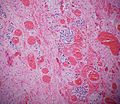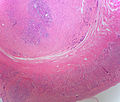Difference between revisions of "Neuroendocrine tumour of the appendix"
Jump to navigation
Jump to search
(redirect) |
m (→Sign out: tweak) |
||
| (10 intermediate revisions by the same user not shown) | |||
| Line 1: | Line 1: | ||
# | '''Neuroendocrine tumour of the appendix''' is a common tumour of the [[vermiform appendix]]. It is also known as '''appendiceal neuroendocrine tumour''', abbreviated '''appendiceal NET'''. | ||
It was previously known as '''appendiceal [[carcinoid]]'''. | |||
==General== | |||
*Most common tumour of the appendix.<ref name=PCPBoD8_435>{{Ref PCPBoD8|435}}</ref> | |||
**Not really common though - one is seen in approximately 300 appendectomies.<ref name=pmid23416502>{{Cite journal | last1 = Mitra | first1 = B. | last2 = Pal | first2 = M. | last3 = Paul | first3 = B. | last4 = Saha | first4 = TN. | last5 = Maiti | first5 = A. | title = Goblet cell carcinoid of appendix: A rare case with literature review. | journal = Int J Surg Case Rep | volume = 4 | issue = 3 | pages = 334-7 | month = | year = 2013 | doi = 10.1016/j.ijscr.2013.01.007 | PMID = 23416502 }}</ref> | |||
===Presentation=== | |||
** Often found incidentally, may be microscopic. | |||
** May cause obstruction leading to mucocele or acute appendicitis. | |||
** May precipitate torsion. | |||
Size matters in ''appendiceal NETs'':<ref name=pmid12569593>{{Cite journal | last1 = Modlin | first1 = IM. | last2 = Lye | first2 = KD. | last3 = Kidd | first3 = M. | title = A 5-decade analysis of 13,715 carcinoid tumors. | journal = Cancer | volume = 97 | issue = 4 | pages = 934-59 | month = Feb | year = 2003 | doi = 10.1002/cncr.11105 | PMID = 12569593 }}</ref> | |||
*<1.0 cm - do not metastasize. | |||
*1.0-2.0 cm - rarely metastasize. | |||
Management: | |||
*Simple resection, e.g. appendectomy, sufficient for most tumours <2 cm.<ref name=pmid25840530>{{Cite journal | last1 = Nussbaum | first1 = DP. | last2 = Speicher | first2 = PJ. | last3 = Gulack | first3 = BC. | last4 = Keenan | first4 = JE. | last5 = Ganapathi | first5 = AM. | last6 = Englum | first6 = BR. | last7 = Tyler | first7 = DS. | last8 = Blazer | first8 = DG. | title = Management of 1- to 2-cm Carcinoid Tumors of the Appendix: Using the National Cancer Data Base to Address Controversies in General Surgery. | journal = J Am Coll Surg | volume = 220 | issue = 5 | pages = 894-903 | month = May | year = 2015 | doi = 10.1016/j.jamcollsurg.2015.01.005 | PMID = 25840530 }}</ref><ref name=pmid18338494>{{Cite journal | last1 = Fornaro | first1 = R. | last2 = Frascio | first2 = M. | last3 = Sticchi | first3 = C. | last4 = De Salvo | first4 = L. | last5 = Stabilini | first5 = C. | last6 = Mandolfino | first6 = F. | last7 = Ricci | first7 = B. | last8 = Gianetta | first8 = E. | title = Appendectomy or right hemicolectomy in the treatment of appendiceal carcinoid tumors? | journal = Tumori | volume = 93 | issue = 6 | pages = 587-90 | month = | year = | doi = | PMID = 18338494 }}</ref> | |||
==Gross== | |||
*Classically found in the tip of the appendix. | |||
*Characteristic yellow cut surface post-[[fixation]]. | |||
*Circumscribed but not encapsulated. | |||
*Firm (due to desmoplasia). | |||
*Centred in the submucosa. | |||
*Nodules that do not usually cause erosion of the overlying mucosa. | |||
===Image=== | |||
<gallery> | |||
Image:Appendiceal_carcinoid_1.JPG | Appendiceal neuroendocrine tumour. (WC) | |||
</gallery> | |||
==Microscopic== | |||
Features: | |||
*Classically subepithelial/mural. | |||
*Various growth patterns: | |||
**Nested (insular). | |||
**Trabecular. | |||
**Palisading. | |||
**Ribbons, [[rosette]]s. | |||
*Fibrous stroma in between cell groups. | |||
*Cytomorphology: | |||
**Monotonous appearance with scanty mitoses. | |||
**Round central nuclei. | |||
**Stippled chromatin ([[AKA]] ''salt-and-pepper chromatin'' and ''coarse chromatin''). | |||
**Eosinophilic granular cytoplasm. | |||
DDx: | |||
*[[Colorectal adenocarcinoma]]. | |||
*Adenocarcinoid. | |||
*[[Crypt cell carcinoma]], also known as ''goblet cell carcinoid''. | |||
*[[Metastasis|Metastatic]] [[adenocarcinoma]]. | |||
*Normal ganglion cells in the Meissner plexus (submucosa) and Auerbach plexus (located between the inner and outer layers of the muscularis propria). | |||
===Special Types=== | |||
*Tubular carcinoid. | |||
**Neuroendocrine cells forming tubules (no cell nests). | |||
**Some tubules can contain mucin. | |||
**Can be confused with adenocarcinoma. | |||
**Features suggesting tubular carcinoid (over adenocarcinoma): | |||
***Arises from base of crypts, with no disruption of surface epithelium. | |||
***No associated epithelial precursor (no adenomatous change). | |||
***Neuroendocrine cytologic features, without prominent atypia. | |||
***IHC (NE markers +ve). | |||
*Goblet cell carcinoid - dealt with in the article ''[[crypt cell carcinoma]]''. | |||
*Signet-ring cells forming glandular structures. | |||
*Possibly also with extra-cellular mucin.{{fact}} | |||
===Images=== | |||
<gallery> | |||
Image: Appendix Carcinoid Torsion 1X PA.JPG|Appendiceal carcinoid with torsion of the appendix - 1x (SKB) | |||
Image: Appendix Carcinoid Torsion LP PA.JPG|Appendiceal carcinoid with torsion of the appendix - low power (SKB) | |||
Image: Appendix Carcinoid Torsion MP PA.JPG|Appendiceal carcinoid with torsion of the appendix - medium power (SKB) | |||
Image: Appendix Carcinoid LP 14BR***.jpg|Appendiceal carcinoid - low power (SKB) | |||
Image: Appendix Carcinoid HP 14BR***.jpg|Appendiceal carcinoid - high power (SKB) | |||
Image: Appendix Carcinoid Synaptophysin 14BR17120.jpg|Appendiceal carcinoid - synaptophysin (SKB) | |||
Image: Appendix Carcinoid LP CTR.jpg|Appendiceal carcinoid - low power (SKB) | |||
Image: Appendix Carcinoid HP CTR.jpg|Appendiceal carcinoid - high power (SKB) | |||
Image: Appendix Carcinoid LP PA.JPG|Appendiceal carcinoid - low power (SKB) | |||
Image: Appendix Carcinoid Necrosis PA.JPG|Appendiceal carcinoid with necrosis (SKB) | |||
</gallery> | |||
www: | |||
*[http://www.humpath.com/spip.php?article10881&id_document=19109#documents_portfolio Appendiceal carcinoid (humpath.com)]. | |||
*[http://www.brown.edu/Courses/Digital_Path/systemic_path/GI/AppendicealCarcinoid.html Carcinoid of the appendix (brown.edu)]. | |||
*[http://www.flickr.com/photos/jian-hua_qiao_md/8494061964/in/photostream/ Appendiceal carcinoid (flickr.com/Qiao)]. | |||
==IHC== | |||
Features: | |||
*Chromogranin A -ve/+ve. | |||
*Synaptophysin +ve. | |||
*Keratin positive.{{fact}} | |||
*S100 positive for appendix.{{fact}} | |||
Others: | |||
*CK7 and CK20 variable.<ref name=pmid22461652>{{Cite journal | last1 = Matsukuma | first1 = KE. | last2 = Montgomery | first2 = EA. | title = Tubular carcinoids of the appendix: the CK7/CK20 immunophenotype can be a diagnostic pitfall. | journal = J Clin Pathol | volume = 65 | issue = 7 | pages = 666-8 | month = Jul | year = 2012 | doi = 10.1136/jclinpath-2011-200639 | PMID = 22461652 }}</ref> | |||
==Sign out== | |||
<pre> | |||
Vermiform Appendix, Appendectomy: | |||
- Low-grade neuroendocrine tumour (carcinoid tumour), see comment. | |||
-- Margins clear. | |||
-- Please see synoptic report. | |||
- Perforated acute appendicitis with periappendicitis. | |||
Comment: | |||
The tumour stains as follows: | |||
POSITIVE: AE1/AE3, chromogranin A, synaptophysin, CD56. | |||
NEGATIVE: CK7, CK20, S100. | |||
PROLIFERATION (Ki-67): <3%. | |||
The low-grade neuroendocrine tumour (in the planes of section) is in the tip and | |||
separate from the appendiceal perforation site/acute appendicitis. | |||
The specimen was submitted in total. | |||
</pre> | |||
==See also== | |||
*[[Vermiform appendix]]. | |||
*[[Neuroendocrine tumours]]. | |||
==References== | |||
{{Reflist|2}} | |||
[[Category:Diagnosis]] | [[Category:Diagnosis]] | ||
[[Category:Vermiform appendix]] | |||
Latest revision as of 14:41, 22 August 2019
Neuroendocrine tumour of the appendix is a common tumour of the vermiform appendix. It is also known as appendiceal neuroendocrine tumour, abbreviated appendiceal NET.
It was previously known as appendiceal carcinoid.
General
- Most common tumour of the appendix.[1]
- Not really common though - one is seen in approximately 300 appendectomies.[2]
Presentation
- Often found incidentally, may be microscopic.
- May cause obstruction leading to mucocele or acute appendicitis.
- May precipitate torsion.
Size matters in appendiceal NETs:[3]
- <1.0 cm - do not metastasize.
- 1.0-2.0 cm - rarely metastasize.
Management:
Gross
- Classically found in the tip of the appendix.
- Characteristic yellow cut surface post-fixation.
- Circumscribed but not encapsulated.
- Firm (due to desmoplasia).
- Centred in the submucosa.
- Nodules that do not usually cause erosion of the overlying mucosa.
Image
Microscopic
Features:
- Classically subepithelial/mural.
- Various growth patterns:
- Nested (insular).
- Trabecular.
- Palisading.
- Ribbons, rosettes.
- Fibrous stroma in between cell groups.
- Cytomorphology:
- Monotonous appearance with scanty mitoses.
- Round central nuclei.
- Stippled chromatin (AKA salt-and-pepper chromatin and coarse chromatin).
- Eosinophilic granular cytoplasm.
DDx:
- Colorectal adenocarcinoma.
- Adenocarcinoid.
- Crypt cell carcinoma, also known as goblet cell carcinoid.
- Metastatic adenocarcinoma.
- Normal ganglion cells in the Meissner plexus (submucosa) and Auerbach plexus (located between the inner and outer layers of the muscularis propria).
Special Types
- Tubular carcinoid.
- Neuroendocrine cells forming tubules (no cell nests).
- Some tubules can contain mucin.
- Can be confused with adenocarcinoma.
- Features suggesting tubular carcinoid (over adenocarcinoma):
- Arises from base of crypts, with no disruption of surface epithelium.
- No associated epithelial precursor (no adenomatous change).
- Neuroendocrine cytologic features, without prominent atypia.
- IHC (NE markers +ve).
- Goblet cell carcinoid - dealt with in the article crypt cell carcinoma.
- Signet-ring cells forming glandular structures.
- Possibly also with extra-cellular mucin.[citation needed]
Images
www:
- Appendiceal carcinoid (humpath.com).
- Carcinoid of the appendix (brown.edu).
- Appendiceal carcinoid (flickr.com/Qiao).
IHC
Features:
- Chromogranin A -ve/+ve.
- Synaptophysin +ve.
- Keratin positive.[citation needed]
- S100 positive for appendix.[citation needed]
Others:
- CK7 and CK20 variable.[6]
Sign out
Vermiform Appendix, Appendectomy:
- Low-grade neuroendocrine tumour (carcinoid tumour), see comment.
-- Margins clear.
-- Please see synoptic report.
- Perforated acute appendicitis with periappendicitis.
Comment:
The tumour stains as follows:
POSITIVE: AE1/AE3, chromogranin A, synaptophysin, CD56.
NEGATIVE: CK7, CK20, S100.
PROLIFERATION (Ki-67): <3%.
The low-grade neuroendocrine tumour (in the planes of section) is in the tip and
separate from the appendiceal perforation site/acute appendicitis.
The specimen was submitted in total.
See also
References
- ↑ Mitchell, Richard; Kumar, Vinay; Fausto, Nelson; Abbas, Abul K.; Aster, Jon (2011). Pocket Companion to Robbins & Cotran Pathologic Basis of Disease (8th ed.). Elsevier Saunders. pp. 435. ISBN 978-1416054542.
- ↑ Mitra, B.; Pal, M.; Paul, B.; Saha, TN.; Maiti, A. (2013). "Goblet cell carcinoid of appendix: A rare case with literature review.". Int J Surg Case Rep 4 (3): 334-7. doi:10.1016/j.ijscr.2013.01.007. PMID 23416502.
- ↑ Modlin, IM.; Lye, KD.; Kidd, M. (Feb 2003). "A 5-decade analysis of 13,715 carcinoid tumors.". Cancer 97 (4): 934-59. doi:10.1002/cncr.11105. PMID 12569593.
- ↑ Nussbaum, DP.; Speicher, PJ.; Gulack, BC.; Keenan, JE.; Ganapathi, AM.; Englum, BR.; Tyler, DS.; Blazer, DG. (May 2015). "Management of 1- to 2-cm Carcinoid Tumors of the Appendix: Using the National Cancer Data Base to Address Controversies in General Surgery.". J Am Coll Surg 220 (5): 894-903. doi:10.1016/j.jamcollsurg.2015.01.005. PMID 25840530.
- ↑ Fornaro, R.; Frascio, M.; Sticchi, C.; De Salvo, L.; Stabilini, C.; Mandolfino, F.; Ricci, B.; Gianetta, E.. "Appendectomy or right hemicolectomy in the treatment of appendiceal carcinoid tumors?". Tumori 93 (6): 587-90. PMID 18338494.
- ↑ Matsukuma, KE.; Montgomery, EA. (Jul 2012). "Tubular carcinoids of the appendix: the CK7/CK20 immunophenotype can be a diagnostic pitfall.". J Clin Pathol 65 (7): 666-8. doi:10.1136/jclinpath-2011-200639. PMID 22461652.










